Plant Disease of the Week--Archived
Week of July 13, 2009...Late Blight of Tomato...
2009 OUTBREAK OF LATE BLIGHT OF TOMATO AND POTATO IN CONNECTICUT
An unusually early and widespread outbreak of late blight of tomato and potato occurred throughout
A fact sheet and photo gallery are available with more detailed information about symptoms and management.
Follow this link to the fact sheet on Late Blight of Tomato and Potato in Connecticut. (568.88, 6 pages, PDF Format)
Follow this link to an image gallery for Late Blight. (753.31kb, 5 pages, PDF Format)
Week of April 20, 2005...Ramorum Blight (Sudden Oak Death)...
Ramorum Blight (Sudden Oak Death) and Connecticut
A potentially devasting, new disease caused by Phytophthora ramorum, a fungus-like organism, has been identified in the United States. To date, natural infections are limited to the West Coast, which includes several coastal counties in California and one county in Oregon. More recently, P. ramorum has also been detected in nurseries in California, Washington, Oregon, and British Columbia. National concern regarding this disease was heightened during 2004 when several shipments of plants from nurseries in California and Oregon were distributed to many states, including Connecticut, and were later determined to test positive for P. ramorum. The detection of P. ramorum in plants shipped to Connecticut and likely planted in our landscape raises many concerns and questions, for many of which, we have no science-based answers. However, we need to proceed with caution since we know very little about the biology and genetics of this pathogen.
Images of Ramorum Blight...
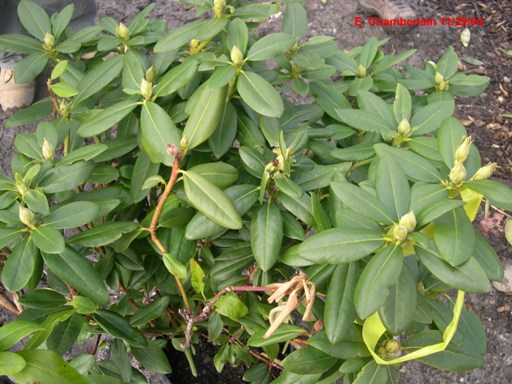
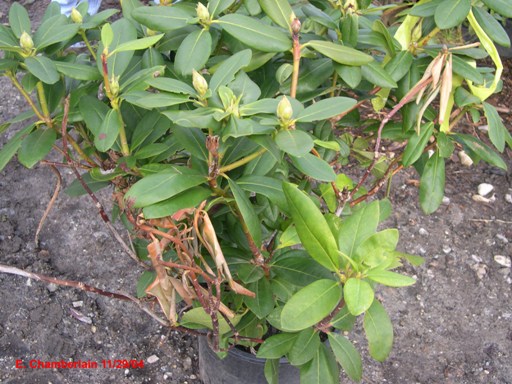

Photos of rhododendron plants infected with P. ramorum that had been shipped to Connecticut. (Photos taken by Eric Chamberlain, USDA APHIS PPQ, Wallingford, CT.)
More detailed information Ramorum Blight can be found in the fact sheets posted on this website: ../../FactSheetFiles/PlantPathology/fspp084.htm.
Week of May 24, 2004...Update on the Eastern Red Cedar Problem...
UPDATE ON THE EASTERN RED CEDAR PROBLEM
In late March and early April 2004, The Plant Disease Information Office started to receive an unusual number of phone inquiries and samples of ailing Eastern red cedar, Juniperus virginiana, from throughout the state. The calls and samples continued to increase into May. Although this native species is usually considered relatively trouble-free in Connecticut, this year we are seeing dramatic and conspicuous damage on trees in all age and size classes, care regimes, and locations, including natural stands and managed landscapes.
SYMPTOMATOLOGY AND POSSIBLE CAUSESSeverely affected trees appear distinctly off-color from a distance. Upon close inspection, a range of symptoms can be observed which includes needle browning and drop, primarily of older, inner needles, tip and twig dieback, and dead branches. In extreme cases, entire trees may turn brown. These symptoms are not distinctive or diagnostic. We have had reports of trees without a history of symptoms or problems exhibiting extensive symptoms this spring. Trees in compromised sites (e.g., exposed to road salt, increasing levels of shade) also exhibited a range of symptoms. In some cases, new growth has been observed at the bases of small, dead twigs. This suggests that cambial tissues are still viable on some of the larger-diameter wood, despite extensive needle browning, drying, and premature drop.
To date, no pathogens, insects, or mites have been directly associated with these symptoms. However, efforts to further characterize and identify the cause(s) are ongoing. One possible scenario to explain the development of the symptoms includes damage from weather conditions of this past winter that occurred on trees previously stressed by several years of dry conditions and the extremely wet conditions of the 2003 season. Although most years, some level of winter damage can be observed on red cedar in spring, the proposed scenario suggests the cumulative effects of these weather factors resulted in greater than usual damage. Winter injury results from many environmental factors which have little in common other than they occur during the winter. Examples of these diverse factors include cool summers followed by warm autumns and sudden drops in temperature, dramatic temperature fluctuations, freeze-thaw cycles, unusually warm, midwinter temperatures, extended periods of extreme or abnormally cold temperatures, and drying winds. Winter desiccation is common on red cedar and results from factors that create a water deficit in the tree. Injury occurs when water evaporates from needles on windy or warm sunny days during the winter or early spring. Drying occurs because this water is not replaced since the roots cannot take up enough water from cold or frozen soil. Lack of water, or drought, normally doesn’t cause problems for red cedar since they are considered to be drought-tolerant. However, extended dry periods for several consecutive years can result in root damage. This damage is often observed in groups of trees rather than in isolated individuals. Excess water can also create periods of waterlogged soils and short-term anaerobic conditions. Red cedar has low anaerobic tolerance. Fact sheets with more detailed information on drought, excess water, and winter injury are available on the Experiment Station website (Listing of all Available Insect-Pest, Plant, and Miscellaneous Fact Sheets) or upon request.
The damage to the red cedars that we’re observing this year is significant but also serves to predispose and weaken the affected trees. This makes them more vulnerable to secondary or opportunistic pests. Among these less serious or secondary problems are tip and twig blights caused by Phomopsis and Kabatina and cankers and diebacks caused by Botryosphaeria. In addition, stressed or weakened trees are more attractive to a number of arthropod pests, including the smaller Japanese cedar longhorn beetle. Consequently, it might be wise to check for infestations next season. Infestations of this longhorn beetle can be recognized as serpentine tunnels on the main trunk or on larger-diameter branches.
Recovery of affected trees is still uncertain and is dependent upon the extent of the damage. Therefore, it needs to be assessed on a tree-by-tree basis. Some trees may show complete recovery whereas others may have substantial and permanent damage.
STRATEGIES FOR MANAGEMENT:Although the weather can’t be controlled and there are no obvious "cures" once the damage is done, there are steps that can minimize the impact of this problem. These include:
-
Use sound cultural practices to promote tree vigor;
-
Have sufficient moisture in the root zone before the soil freezes-- this can be accomplished by giving the trees a deep watering before the ground freezes in the fall; mulching also helps to increase moisture retention in the winter;
-
Avoid late summer and early fall fertilization-- this stimulates and encourages growth late in the season which may not harden-off properly for the winter;
-
Prune and remove any dead twigs or branches;
-
Scout for secondary invaders and/or opportunistic pests.
Since we are still investigating this new problem, you can contact the Experiment Station for the most current information.
Week of March 22, 2004...Winter-Related Problems....
Winter-Related Problems with Evergreens
This winter’s weather has been conducive for problems on needled and broadleaved evergreens and symptoms are beginning to show up throughout Connecticut. Several key factors contributing to plant injury this year are desiccation, unusually cold temperatures, and de-icing salts. Desiccation or excessive drying is common after windy or sunny days during the winter. These conditions create a water deficit because water lost by leaves or needles is not replaced since roots can’t take up water from cold or frozen soil. This winter we had several weeks of extremely cold temperatures. These conditions can damage flower and shoot buds on many woody plants but the extent of the damage will not become evident until the plants begin to grow in spring. This winter’s unusually high snowfall levels resulted in extensive use of de-icing salts. De-icing salts cause damage through direct contact of salt solutions with plant foliage ("spray zone" injury) and through chemical and physical modification of the soil as a result of accumulating salt and uptake of salt ions by plant roots. Symptoms associated with these factors are quite variable and depend upon the plant. For example, needles of hemlock and pine are turning brown and leaves of rhododendron and mountain laurel are developing marginal and tip necrosis.
More detailed information about how damage occurs and on how to minimize the effects of this important environmental stress can be found in the fact sheets PP055 Winter Injury and Drying of Rhododendron, PP056 Winter Injury on Woody Ornamentals, and PP0014 De-icing Salts: Damage to Woody Ornamentals.
Images of Winter Injury...
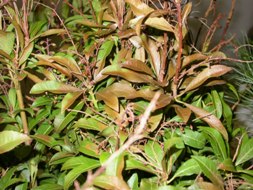
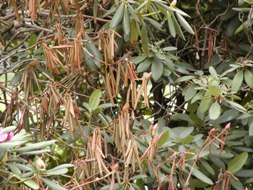
Week of April 14, 2003...Winter-Related Problems with Evergreens...
Winter-Related Problems with Evergreens
This winter’s weather has been conducive for problems on needled and broadleaved evergreens and symptoms are beginning to show up throughout Connecticut. Several key factors contributing to plant injury this year are desiccation, unusually cold temperatures, and de-icing salts. Desiccation or excessive drying is common after windy or sunny days during the winter. These conditions create a water deficit because water lost by leaves or needles is not replaced since roots can’t take up water from cold or frozen soil. This winter we had several weeks of extremely cold temperatures. These conditions can damage flower and shoot buds on many woody plants but the extent of the damage will not become evident until the plants begin to grow in spring. This winter’s unusually high snowfall levels resulted in extensive use of de-icing salts. De-icing salts cause damage through direct contact of salt solutions with plant foliage ("spray zone" injury) and through chemical and physical modification of the soil as a result of accumulating salt and uptake of salt ions by plant roots. Symptoms associated with these factors are quite variable and depend upon the plant. For example, needles of hemlock and pine are turning brown and leaves of rhododendron and mountain laurel are developing marginal and tip necrosis.
More detailed information about how damage occurs and on how to minimize the effects of this important environmental stress can be found in the fact sheets PP055 Winter Injury and Drying of Rhododendron, PP056 Winter Injury on Woody Ornamentals, and PP0014 De-icing Salts: Damage to Woody Ornamentals.
Images of Winter Injury...
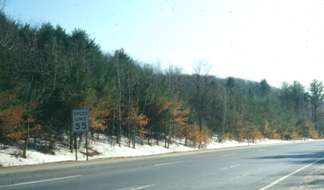
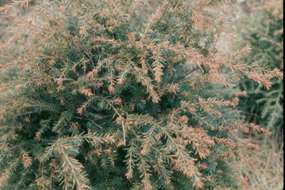
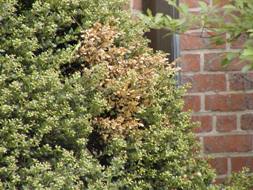
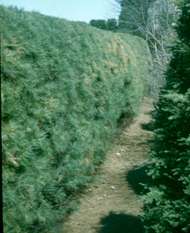
Week of April 1, 2002...Drought and Its After-Effects...
Drought and Its After-Effects
This year drought is a key factor for consideration as the growing season approaches in Connecticut. The current season’s drought follows a trend for abnormally low levels of precipitation that has been occurring since 1995. Symptoms of drought are manifest in different ways depending upon the plant species and the severity of the water deficit. Obvious symptoms of drought appear on herbaceous plants such as bedding plants, annuals, and even some perennials--when soil moisture is deficient, plants wilt, shrivel, and frequently die. In these cases, the cause and effect are usually apparent. The situation with woody plants, however, is much more complicated. Symptoms associated with drought are variable and include loss of turgor in needles and leaves, drooping, wilting, yellowing, premature leaf, needle or fruit drop, stunting, and tip or branch dieback. Leaves on deciduous trees often develop a marginal scorch and interveinal necrosis whereas needles on evergreens turn brown at the tips. In extreme cases, drought can result in plant death. Effects of drought are typically more severe on new transplants but established plants are also affected. In some cases, symptoms aren’t evident on woody ornamentals until sometime after the injury has occurred--even as much as one or two years later.
More detailed information about how damage occurs and on how to minimize the effects of this important environmental stress can be found in the fact sheets PP025 Drought and Its After-Effects on Trees and Shrubs and PP026 Drought Stress, Tree Health, and Management Stategies.
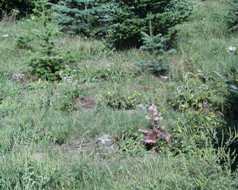
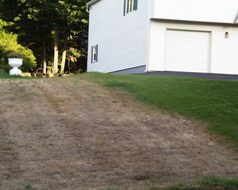
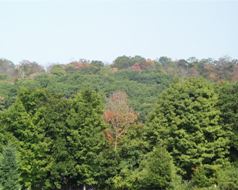
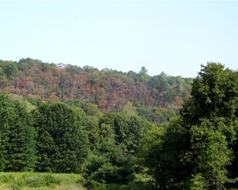
Week of July 2, 2001...Slime Molds...
Slime MoldsAlthough slime molds are not pathogenic to plants, they are highly conspicuous fungi that often seem to "magically" appear on mulch, plants, and turf overnight. The rapid appearance of these nuisance fungi is frequently a cause for misdirected alarm. These fungi have also been the source of countless stories and colorful names such as the "blob" and the "dog vomit fungus." Slime molds are easily recognized by their brightly colored structures. The most common slime molds on mulch appear as bright yellow, orange, or creamy tan irregular masses... for more information, see the fact sheet PP067 Slime Molds...
Images of Slime Molds...
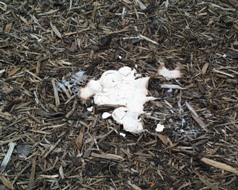
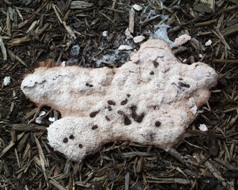
Week of April 30, 2001...Winter Injury and Drying of Rhododendron...
Winter Injury and Drying of RhododendronAs a result of the weather this winter and of these past few years, many rhododendrons throughout Connecticut are exhibiting symptoms of winter injury and desiccation...For more information check our factsheets: PP055 Winter Injury and Drying of Rhododendrons and PP025 Drought and Its Affects on Trees and Shrubs...
Images of Winter Injury on Rhododendrons...
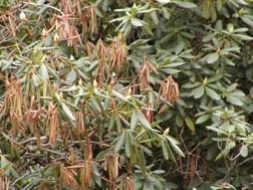
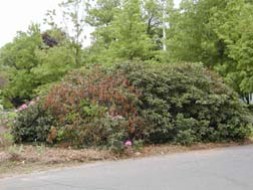
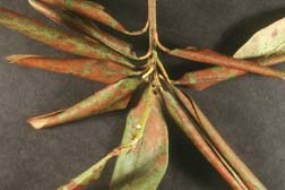
Updated 25 May 2010

